Approximate Analytic Solutions of Time-Fractional Hirota-Satsuma Coupled KdV Equation and Coupled MKdV Equation
Abstract
By introducing the fractional derivative in the sense of Caputo and combining the pretreatment technique to deal with long nonlinear items, the generalized two-dimensional differential transform method is proposed for solving the time-fractional Hirota-Satsuma coupled KdV equation and coupled MKdV equation. The presented method is a numerical method based on the generalized Taylor series expansion which constructs an analytical solution in the form of a polynomial. The numerical results show that the generalized two-dimensional differential transform method is very effective for the fractional coupled equations.
1. Introduction
In the last past decade, the fractional differential equations have been widely used in various fields of physics and engineering. The analytical approximation of such problems has attracted great attention and became a considbased onerable interest in mathematical physics. Some powerful methods including the homotopy perturbation method [1], Adomian decomposition method [2, 3], variational iteration method [4, 5], homotopy analysis method [6, 7], fractional complex transform method [8], and generalized differential transform method [9] have been developed to obtain exact and approximate analytic solutions. These solution techniques are more clear and realistic methods for fractional differential equations, because they give the approximate solutions of the considered problems without any linearization or discretization.
The variational iteration method and the homotopy perturbation method were first proposed by Professor He in [10, 11], respectively. The idea of the variational iteration method is to construct correction functionals using general Lagrange multipliers identified optimally via the variational theory, and the initial approximations can be freely chosen with unknown constants. Recently, Wu and Lee proposed a fractional variational iteration method for fractional differential equation based on the modified Riemann CLiouville derivative, which is more effective to solve fractional differential equation [12]. This method has been developed by many authors, see [13–16] and the references cited therein. The homotopy perturbation method, which does not require a small parameter in an equation, has a significant advantage that it provides an analytical approximate solution to a wide range of nonlinear problems in applied sciences. Recently, the fractional complex transform is developed to convert the fractional differential equation to its differential partner and gave a geometrical explanation [8]. These methods are more effective for solving the linear and nonlinear fractional differential equations.
The differential transform method was used firstly by Zhou in 1986 to study electric circuits [17]. The differential transform is an iterative procedure based on the Taylor series expansion which constructs an analytic solution in the form of a polynomial. The method is well addressed in [18–23]. Recently, the generalized differential transform method is developed for obtaining approximate analytic solutions for some linear and nonlinear differential equations of fractional order [24, 25].
The Caputo fractional derivative is considered here because it allows traditional initial and boundary conditions to be included in the formulation of the problem.
Definition 1 (see [27].)The fractional derivative of f(x) in the Caputo sense is defined as
Definition 2 (see [28].)For m to be the smallest integer that exceeds α, the Caputo time-fractional derivative of order α > 0 is defined as
Lemma 3 (see [29].)The Caputo fractional derivative of the power function satisfies
2. Generalized Two-Dimensional Differential Transform Method (GDTM)
The fundamental theorems of the generalized two-dimensional differential transform are as follows.
Theorem 4. Suppose that Uα,β(k, h), Vα,β(k, h), and Wα,β(k, h) are the differential transformations of the functions u(x, t), v(x, t), and w(x, t), respectively:
- (a)
if u(x, t) = v(x, t) ± w(x, t), then Uα,β(k, h) = Vα,β(k, h) ± Wα,β(k, h).
- (b)
if u(x, t) = av(x, t), a ∈ ℝ, then Uα,β(k, h) = aVα,β(k, h).
- (c)
if u(x, t) = v(x, t)w(x, t), then .
- (d)
if u(x, t) = (x − x0) nα(t − t0) mβ, then Uα,β(k, h) = δ(k − n)δ(h − m).
- (e)
if , then Uα,β(k, h) = (Γ(α(k + 1) + 1)/Γ(αk + 1))Vα,β(k + 1, h).
Theorem 5. If u(x, t) = f(x)g(t), function f(x) = xλh(x), where λ > −1 and h(x) has the generalized Taylor series expansion ,
- (i)
β < λ + 1 and α arbitrary, or
- (ii)
β ≥ λ + 1, α arbitrary, and an = 0 for n = 0,1, …, m − 1, where m − 1 < β ≤ m,
Some details of the aformentioned theorems can be found in [30].
3. Applications of GDTM
3.1. Fractional Hirota-Satsuma Coupled KdV Equation
In order to verify whether the approximate solutions of (22)–(24) lead to higher accuracy, we draw the figures of the approximate solutions of (22)–(24) with α = 1, as well as the exact solutions (13) when c0 = c2 = 1, γ = 0.1, and β = 0.08. It can be seen from Figures 1(a) to 3(b) that the solutions obtained by the presented method is nearly identical with the exact solutions. So, we conclude that a good approximation is achieved by using the GDTM.
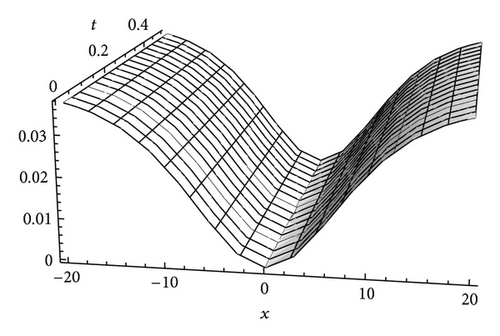
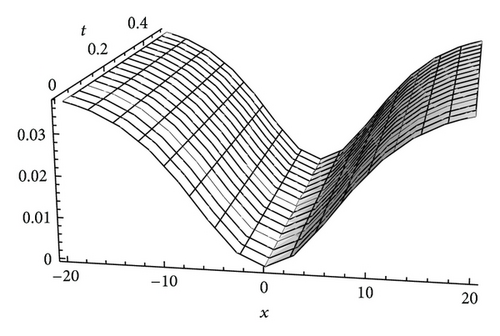
3.2. Fractional Coupled MKdV Equation
The effectiveness and accuracy of the approximate solutions can be seen from the comparison figures.
Figures 4 and 5 show the approximate solutions of (36) and (37) and the exact ones of (31) with α = λ = 1 and γ = 0.1, respectively. Comparing Figures 1(a) and 1(b) with Figures 2(a) and 2(b), we can see that the solutions obtained by different methods are nearly identical. From these figures, we can know that the series solutions converge rapidly, so a good approximation has been achieved.
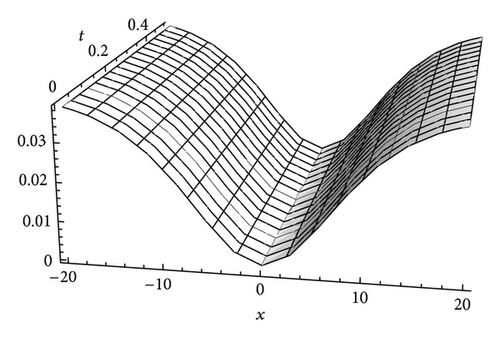
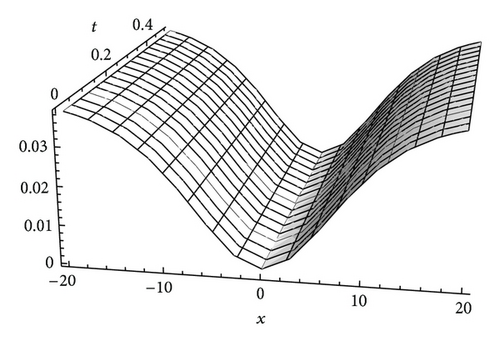
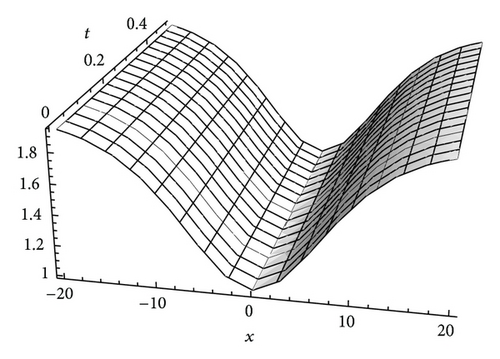

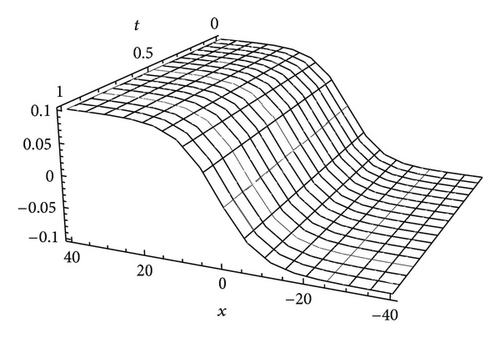
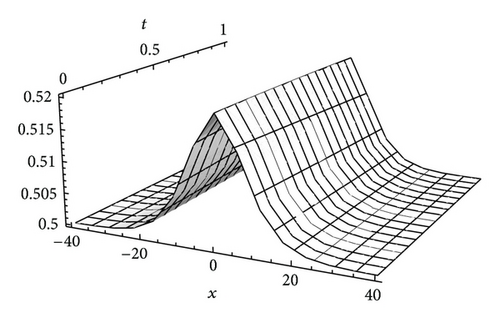

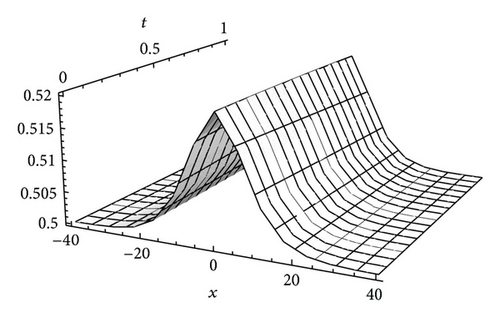
4. Summary and Discussion
In this paper, combining the Caputo fractional derivative, the GDTM was applied to derive approximate analytical solutions of the time-fractional Hirota-Satsuma coupled KdV equation and coupled MKdV equation with initial conditions. The numerical solutions obtained from the GDTM are shown graphically. The obtained results demonstrate the reliability of the algorithm and its wider applicability to nonlinear fractional coupled partial differential equations.
Setting um(x, t) = um(x)(tmβ/Γ(1 + mβ)) and vm(x, t) = vm(x)(tmβ/Γ(1 + mβ)), and using (43), we can obtain the 3-order approximate solutions as (36) and (37) by using the symbol computational software Mathematica.
Acknowledgments
The project is supported by the NNSF of China (11061021), the NSF-IMU of China (2012MS0105, 2012MS0106), and the YSF-IMU of China (ND0811).




